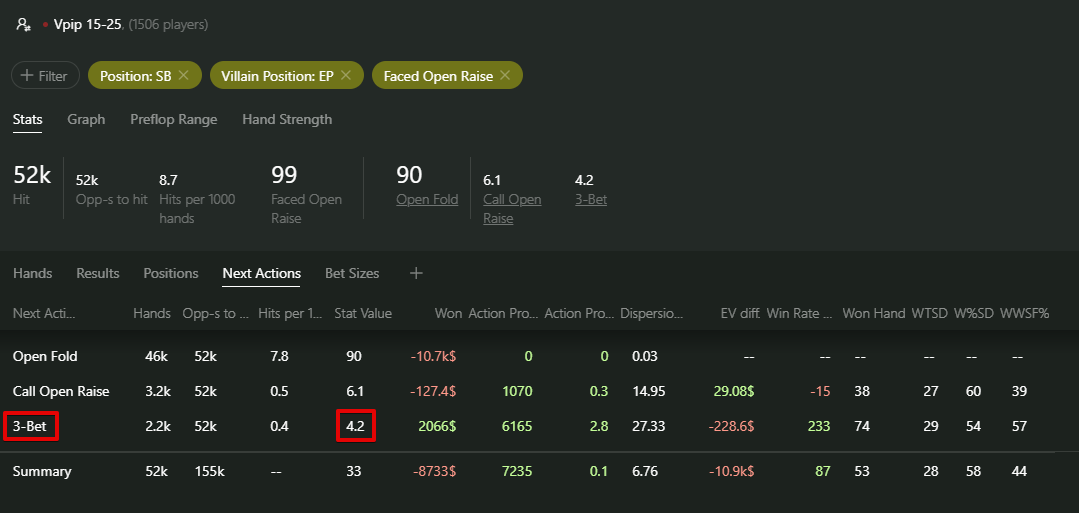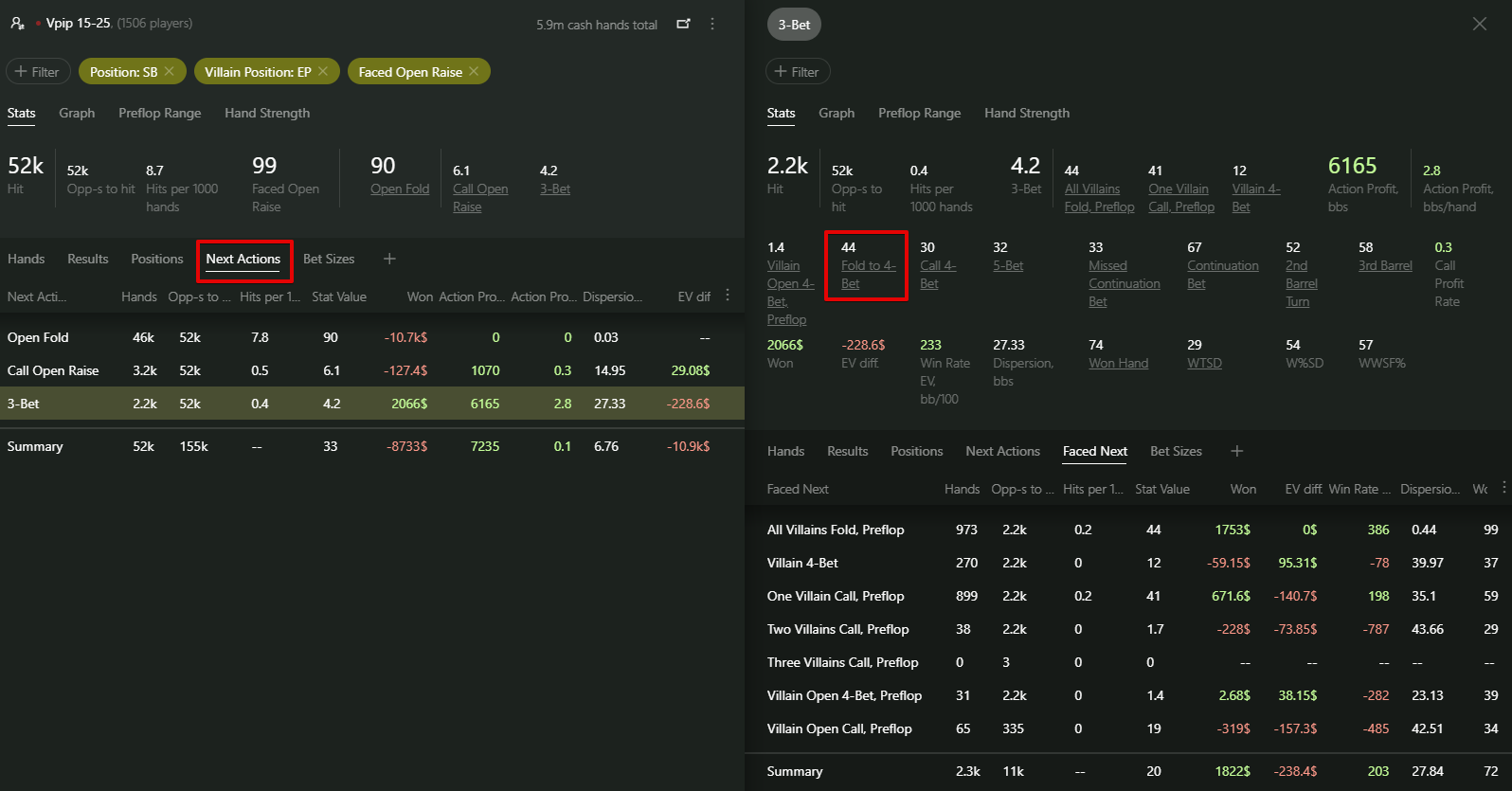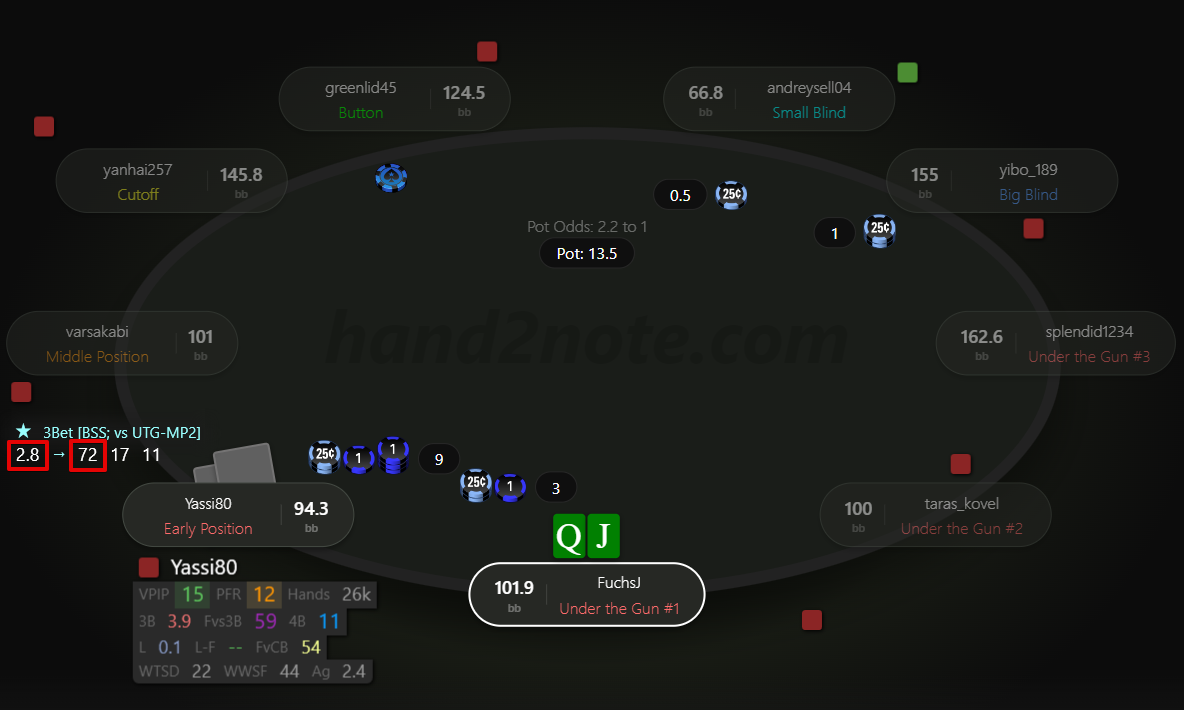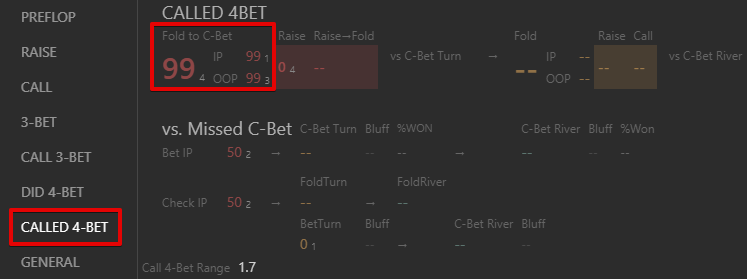4-Bet Bluffing: Exploiting Opponents
We have already discussed suitable situations for 3-bets, but what should we do when we’ve open-raised preflop and faced a 3-bet from our opponent? One of the most powerful moves in poker that can confuse your opponents is the 4-bet bluff.
In this article, we’ll explore four key factors to consider when deciding on a bluff 4-bet which determine its success.
Table of Contents:
- Your opponent’s 3-bet frequency
- How often your opponent folds to a 4-bet
- How often your opponent folds to flop continuation bet in a 4-bet pot
# Your table position
Your table position is a crucial aspect when deciding on a bluff 4-bet. If you open-raise from early positions, players generally understand that you are likely to have a strong hand, and they tend to 3-bet with only very strong hands, occasionally adding bluffs to their range.
Conversely, opponents are more likely to attack late position raises with bluff 3-bets, understanding that you might be attempting to steal blinds with a weak hand.
Let’s leverage multi-player reports in Hand2Note 4 to see the correlation between the initial raiser’s position and opponents’ 3-bet ranges.
Thanks to this feature in Hand2Note 4, you can easily and accurately track general tendencies of players with a similar playing style at your limits.

For the report, I have selected tight regular players with VPIP values ranging from 15 to 25, for each of whom I have at least 1000 hands in my database. Using filters, I simulated a scenario where these players faced an open raise from an Early Position while being in the Small Blind.
In the screenshot above, we can see that in such a situation, the 3-bet range of regular players is very narrow, comprising only 4.2%.
Let’s modify our situation and specify that the open raise came not from an Early Position but from the Button, and see how this affects the 3-bet range of tight players.

We observe that their 3-bet range from the Small Blind has expanded to 12%, nearly three times its previous size. Within such a range, there will likely be a considerable number of weak hands that we can bluff out with a 4-bet.
# Your opponent’s 3-bet frequency
Another crucial factor to consider when deciding on a bluff 4-bet is your opponent’s 3-bet frequency. The more often a player employs 3-bets, the wider their range becomes, meaning there are more weak hands in it that your opponent will be forced to fold to a 4-bet.
Let’s return to the multi-player reports we have obtained in Hand2Note 4 and track how often regular players fold to 4-bets based on their 3-bet frequency.

Reports navigation in Hand2Note 4 has become even more convenient and interactive. If you click on the “Next Actions” tab in the report and then click on the “3-bet” line, another report will appear on the right, allowing us to analyze player tendencies after they make a 3-bet.
So, we can notice that in situations where the 3-bet frequency of regular players is 4.2%, they fold to a 4-bet on average in 44% of cases, which is not overly frequent.

And when the frequency with which they 3-bet increases to 12%, then, when facing a 4-bet, they fold in 55% of cases, meaning that most of the time, we’ll still be able to take down the pot with a bluff 4-bet.
# How often your opponent folds to a 4-bet
Another crucial aspect is the frequency with which your opponent folds to a 4-bet. In Hand2Note 4, there’s a specific stat called “Fold to 4-bet” that you can add to your HUD or pop-up to assess how often a player gives up when confronted with a 4-bet.
The more frequently your opponent folds, the more often you can employ a bluff 4-bet. Don’t miss out on a profitable spot where you can win the pot without much resistance. Here’s how it works in practice:

We open-raised with QJ suited from an early position at the full ring and faced a 3-bet from the player sitting right behind us. In the dynamic HUD of Hand2Note 4, we can see that our opponent’s 3-bet frequency is only 2.8%, indicating a very narrow and strong range. So, what should we do?
The initial thought might be to simply fold our cards, but the HUD reveals a significant leak in our opponent’s game that we can exploit.
After this player 3-bets against an early position and then faces a 4-bet, they fold 72% of the time, which is quite frequent. Therefore, against this opponent, a bluff 4-bet would be a highly profitable decision, and we should lean towards such a play.
# How often your opponent folds to flop continuation bet in a 4-bet pot
If your opponent rarely folds to a 4-bet preflop but tends to fold frequently to a continuation bet on the flop, you can consider going for a 4-bet bluff with a plan to apply further pressure.
In such a scenario, the move remains effective, but the selection of bluffing hands requires a more careful approach. Give preference to suited connectors with blockers to your opponent’s strong hands and the potential to form a powerful combination.
For a 4-bet bluff, the hands like A5 or KQ suited are appropriate. In the event that your opponent calls the 4-bet, these hands can connect well with the flop and have the potential to win at showdown. Thus, your continuation bet on the flop becomes a semi-bluff rather than a pure bluff.
Let’s consider an example of a suitable situation for a 4-bet bluff:

We made an open raise from an early position with KQ suited, and our opponent in the Big Blind responded with a 3-bet. In the dynamic HUD of Hand2Note 4, we can observe that when in the Big Blind, this player 3-bets against early positions in 4.5% of cases, indicating a relatively narrow range.
Additionally, the HUD shows that by the time of the hand, our opponent has never folded to a 4-bet in this situation. It might seem like a bluff 4-bet from our side would be a waste of money, but that’s not the case.

In the opponent’s pop-up, we can see that, after calling the 4-bet preflop, he folded to a continuation bet on the flop all four times out of four. Therefore, a 4-bet bluff from our side in this situation would be a very strong and correct play.
4-bet bluffing is a powerful tool that allows you to assert dominance over your opponents and win pots even without strong hands. However, for its successful application, it’s crucial to consider the specifics of the spot and analyze the playing tendencies of your opponents.
With Hand2Note 4, you will be able to make more informed decisions and identify profitable opportunities for bluff 4-bets.
# 4-Bet Bluffing: Exploiting Opponents
We have already discussed suitable situations for 3-bets, but what should we do when we’ve open-raised preflop and faced a 3-bet from our opponent? One of the most powerful moves in poker that can confuse your opponents is the 4-bet bluff.
In this article, we’ll explore four key factors to consider when deciding on a bluff 4-bet which determine its success.
Table of Contents:
- Your opponent’s 3-bet frequency
- How often your opponent folds to a 4-bet
- How often your opponent folds to flop continuation bet in a 4-bet pot
# Your table position
Your table position is a crucial aspect when deciding on a bluff 4-bet. If you open-raise from early positions, players generally understand that you are likely to have a strong hand, and they tend to 3-bet with only very strong hands, occasionally adding bluffs to their range.
Conversely, opponents are more likely to attack late position raises with bluff 3-bets, understanding that you might be attempting to steal blinds with a weak hand.
Let’s leverage multi-player reports in Hand2Note 4 to see the correlation between the initial raiser’s position and opponents’ 3-bet ranges.
Thanks to this feature in Hand2Note 4, you can easily and accurately track general tendencies of players with a similar playing style at your limits.

For the report, I have selected tight regular players with VPIP values ranging from 15 to 25, for each of whom I have at least 1000 hands in my database. Using filters, I simulated a scenario where these players faced an open raise from an Early Position while being in the Small Blind.
In the screenshot above, we can see that in such a situation, the 3-bet range of regular players is very narrow, comprising only 4.2%.
Let’s modify our situation and specify that the open raise came not from an Early Position but from the Button, and see how this affects the 3-bet range of tight players.

We observe that their 3-bet range from the Small Blind has expanded to 12%, nearly three times its previous size. Within such a range, there will likely be a considerable number of weak hands that we can bluff out with a 4-bet.
# Your opponent’s 3-bet frequency
Another crucial factor to consider when deciding on a bluff 4-bet is your opponent’s 3-bet frequency. The more often a player employs 3-bets, the wider their range becomes, meaning there are more weak hands in it that your opponent will be forced to fold to a 4-bet.
Let’s return to the multi-player reports we have obtained in Hand2Note 4 and track how often regular players fold to 4-bets based on their 3-bet frequency.

Reports navigation in Hand2Note 4 has become even more convenient and interactive. If you click on the “Next Actions” tab in the report and then click on the “3-bet” line, another report will appear on the right, allowing us to analyze player tendencies after they make a 3-bet.
So, we can notice that in situations where the 3-bet frequency of regular players is 4.2%, they fold to a 4-bet on average in 44% of cases, which is not overly frequent.

And when the frequency with which they 3-bet increases to 12%, then, when facing a 4-bet, they fold in 55% of cases, meaning that most of the time, we’ll still be able to take down the pot with a bluff 4-bet.
# How often your opponent folds to a 4-bet
Another crucial aspect is the frequency with which your opponent folds to a 4-bet. In Hand2Note 4, there’s a specific stat called “Fold to 4-bet” that you can add to your HUD or pop-up to assess how often a player gives up when confronted with a 4-bet.
The more frequently your opponent folds, the more often you can employ a bluff 4-bet. Don’t miss out on a profitable spot where you can win the pot without much resistance. Here’s how it works in practice:

We open-raised with QJ suited from an early position at the full ring and faced a 3-bet from the player sitting right behind us. In the dynamic HUD of Hand2Note 4, we can see that our opponent’s 3-bet frequency is only 2.8%, indicating a very narrow and strong range. So, what should we do?
The initial thought might be to simply fold our cards, but the HUD reveals a significant leak in our opponent’s game that we can exploit.
After this player 3-bets against an early position and then faces a 4-bet, they fold 72% of the time, which is quite frequent. Therefore, against this opponent, a bluff 4-bet would be a highly profitable decision, and we should lean towards such a play.
# How often your opponent folds to flop continuation bet in a 4-bet pot
If your opponent rarely folds to a 4-bet preflop but tends to fold frequently to a continuation bet on the flop, you can consider going for a 4-bet bluff with a plan to apply further pressure.
In such a scenario, the move remains effective, but the selection of bluffing hands requires a more careful approach. Give preference to suited connectors with blockers to your opponent’s strong hands and the potential to form a powerful combination.
For a 4-bet bluff, the hands like A5 or KQ suited are appropriate. In the event that your opponent calls the 4-bet, these hands can connect well with the flop and have the potential to win at showdown. Thus, your continuation bet on the flop becomes a semi-bluff rather than a pure bluff.
Let’s consider an example of a suitable situation for a 4-bet bluff:

We made an open raise from an early position with KQ suited, and our opponent in the Big Blind responded with a 3-bet. In the dynamic HUD of Hand2Note 4, we can observe that when in the Big Blind, this player 3-bets against early positions in 4.5% of cases, indicating a relatively narrow range.
Additionally, the HUD shows that by the time of the hand, our opponent has never folded to a 4-bet in this situation. It might seem like a bluff 4-bet from our side would be a waste of money, but that’s not the case.

In the opponent’s pop-up, we can see that, after calling the 4-bet preflop, he folded to a continuation bet on the flop all four times out of four. Therefore, a 4-bet bluff from our side in this situation would be a very strong and correct play.
4-bet bluffing is a powerful tool that allows you to assert dominance over your opponents and win pots even without strong hands. However, for its successful application, it’s crucial to consider the specifics of the spot and analyze the playing tendencies of your opponents.
With Hand2Note 4, you will be able to make more informed decisions and identify profitable opportunities for bluff 4-bets.















